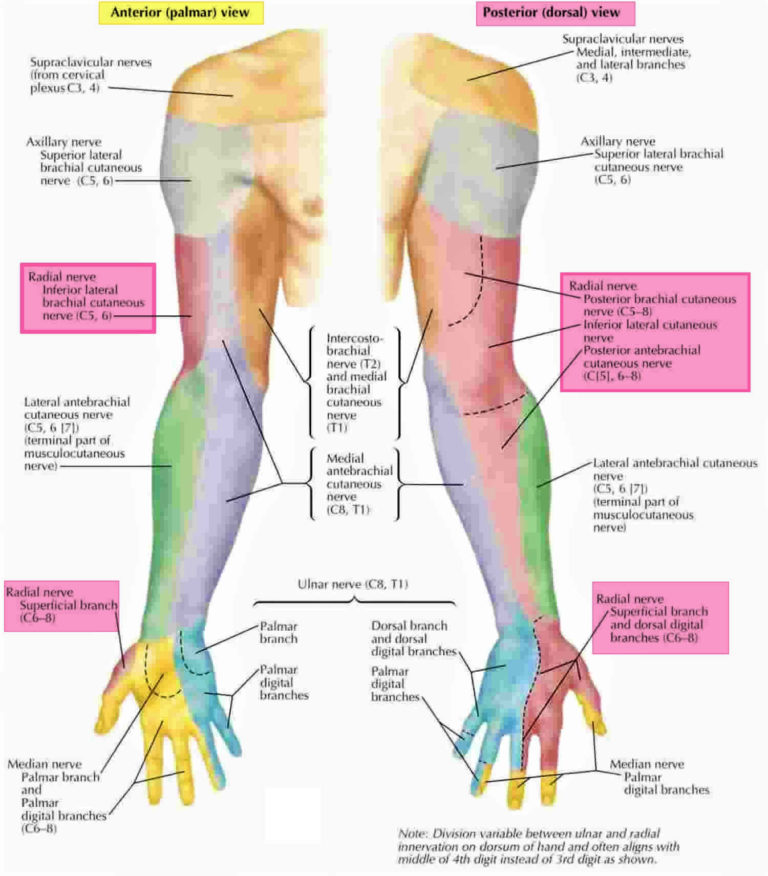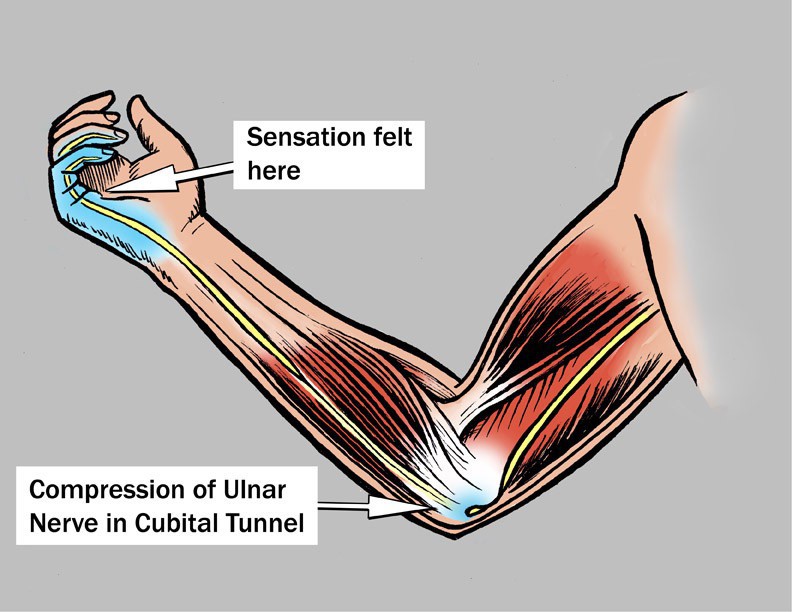One can also place the palm against a wall at shoulder height, if the stretch needs modifying. Treatments can include a combination of physical therapy and medications to help with symptoms. If people do not respond to these treatments, surgery may be an option.

There are many surgical techniques to treat radial tunnel syndrome, and there can be significant differences in surgical outcomes. A common way is to make a cut between the forearm muscles to open the space for the nerve to pass through. The surgeon will remove all sites of compression on the nerve. Some surgeons will also treat tennis elbow, which can occur at the same time as radial tunnel syndrome, during the surgery. Recovery might take three to six months and benefit from therapy to allow muscles and nerves to recover and prevent scarring. Risks of surgery include general risks of anesthesia, injury to the nerve, persistent pain, scarring, and weakness.
Therapy (Active and Passive)
Localized tenderness to the entrance of the radial tunnel should be compared bilaterally along with the radial head and lateral epicondyle. The physician may extend and maneuver the arm to compare pain levels during pronation and supination or resistance to these motions. X-rays of the elbow, MRI of the cervical spine, electromyography, and nerve conduction studies may also be helpful for a definitive diagnosis.

Since it can worsen over time, symptoms can include loss of strength in the wrists over time, inability to grasp things, and general fatigue in the arms than usual. Since the nerve is impacted, one of the first symptoms is the reduction in movement in the arms. Other symptoms are pain when extending or contracting the arms, swelling in the elbow and forearms, and throbbing pain in the forearms. To reduce pressure on the nerve, the person should wear a splint on the wrist and/or the elbow and avoid rotating the wrist and bending the arm at the elbow. The goal of the treatment is to reduce pain from coming back.
Continuing Education Activity
Your primary goal after you’ve recovered, whether it be after surgery or non-surgical treatment, should be to avoid any sort of re-injury to your radial nerve. If all conservative measures fail, surgery is recommended to relieve the radial nerve from pressure in the radial tunnel. It helps to reduce inflammation caused due to muscle or ligament damage in the elbow joint. Ice fomentation also helps to restrict seepage of blood from the capillaries. The most important part of treatment is to stop activities which may have caused radial tunnel syndrome. Avoid activities which may require frequent bending of wrist in backward direction.
Stretching and strengthening the muscles of the forearm can also help to relieve your pain and tenderness. If it’s performed, it would usually be done as an outpatient surgery. Although reported less often, some patients describe the pain as cutting, piercing, or stabbing.
Meet the Doctor
These patients present with radicular type pain, numbness, tingling, and weakness depending on which level is affected. An MRI can assess for foraminal stenosis, and targeted injections can be useful in determining symptomatic levels. Review interprofessional team strategies for improving care coordination and communication to advance the management of radial tunnel syndrome and improve outcomes.

Radial tunnel syndrome occurs when the radial nerve becomes pinched or compressed. Symptoms might include a dull ache or pain in the arm, limited mobility, and weakness. The radial tunnel is defined as a five-centimeter potential space in the dorsal aspect of the forearm extending from the level of the radiocapitellar joint to the proximal edge of the supinator. It is bordered laterally by the brachioradialis, ECRL, and ECRB muscles. The medial border consists of the biceps tendon and brachialis muscle.
The variety of treatment options for tarsal tunnel syndrome often bring relief. One key is diagnosing the condition early, before nerve damage accumulates and when treatments are most effective. Other symptoms are the inability to engage in physical activities such as lifting things, carrying items, and engaging in sports. Pain while throwing something, engaging the arms for quick actions such as pulling and pushing, fatigue during driving or riding, cooking, writing, and typing can all be symptoms of Radial Syndrome. This releases pressure on the radial nerve and allows more space. Some suggest that muscle tightness can increase pressure upon the affected nerve.
Classically, patients with lateral epicondylitis are point tender over the lateral epicondyle and not the dorsal forearm. Additionally, wrist flexion and passive pronation can reproduce the dorsoradial proximal forearm pain by increasing the pressure in the radial tunnel to 250 mm Hg. Notably, patients with radial tunnel syndrome should not have a weakness. This is contrasted with PIN compression syndrome, where the weakness of the wrist extensors is a significant examination finding secondary to damage of the myelin of the PIN.
A curvilinear or lazy-S incision is performed, starting just proximal to the lateral epicondyle of the elbow with an extension along the interval between brachioradialis and biceps distally. The incision is carried along the ulnar border of the brachioradialis and the mobile wad. In the interval between brachialis and brachioradialis, the radial nerve proper should be identified.

This includes reducing pain, numbness, tingling, and weakness in the affected hand and fingers. A brace is one possible treatment for radial tunnel syndrome. This type of device can help to stabilize the affected area and relieve pressure on the compressed nerve. Some patients may find that a brace helps to relieve their symptoms, while others may not. The best way to determine if a brace is right for you is to speak with your doctor or orthopedic specialist. They will be able to assess your individual case and make a recommendation based on your specific needs.

No comments:
Post a Comment